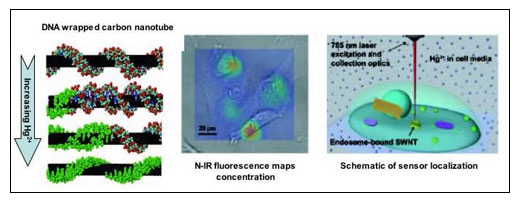CHAMPAIGN, Ill., Feb. 6, 2006 -- Single-walled carbon nanotubes wrapped with DNA can be placed inside living cells and detect trace amounts of harmful contaminants using near-infrared (NIR) light, report researchers at the University of Illinois. Their discovery could lead to the creation of new types of optical sensors and biomarkers that take advantage of the unique properties of nanoparticles in living systems.
 “This is the first nanotube-based sensor that can detect analytes at the subcellular level,” said Michael Strano, a professor of chemical and biomolecular engineering at Illinois and corresponding author of a paper that appeared in the Jan. 27 issue of the journal Science. “We also show for the first time that a subtle rearrangement of an absorbed biomolecule can be directly detected by a carbon nanotube.”
“This is the first nanotube-based sensor that can detect analytes at the subcellular level,” said Michael Strano, a professor of chemical and biomolecular engineering at Illinois and corresponding author of a paper that appeared in the Jan. 27 issue of the journal Science. “We also show for the first time that a subtle rearrangement of an absorbed biomolecule can be directly detected by a carbon nanotube.”
At the heart of the new detection system is the transition of DNA secondary structure from the native, right-handed “B” form to the alternate, left-handed “Z” form. “We found that the thermodynamics that drive the switching back and forth between these two forms of DNA structure would modulate the electronic structure and optical emission of the carbon nanotube,” said Strano, who is also a researcher at the Beckman Institute for Advanced Science and Technology and at the university’s micro- and nanotechnology laboratory.
 |
A University of Illinois research team's discovery about DNA-wrapped carbon nanotubes could lead to the creation of new types of optical sensors and biomarkers that exploit the unique properties of nanoparticles in living systems. (Image: University of Illinois)
|
To make their sensors, the researchers begin by wrapping a piece of double-stranded DNA around the surface of a single-walled carbon nanotube in a way similar to how a telephone cord wraps around a pencil. The DNA starts by wrapping around the nanotube with a certain shape that is defined by the negative charges along its backbone.
When the DNA is exposed to ions of certain atoms, such as calcium, mercury and sodium, the negative charges become neutralized and the DNA changes shape in a similar manner to its natural shape-shift from the B form to Z form. This reduces the surface area covered by the DNA, perturbing the electronic structure and shifting the nanotube’s natural, NIR fluorescence to a lower energy.
“The change in emission energy indicates how many ions bind to the DNA,” said graduate student Daniel Heller, lead author of the paper. “Removing the ions will return the emission energy to its initial value and flip the DNA back to the starting form, making the process reversible and reusable.”
The researchers demonstrated the viability of their measurement technique by detecting low concentrations of mercury ions in whole blood, opaque solutions and living mammalian cells and tissues -- examples where optical sensing is usually poor or ineffective. Because the signal is in the NIR, a property unique to only a handful of materials, it is not obscured by the natural fluorescence of polymers and living tissues.
“The nanotube surface acts as the sensor by detecting the shape change of the DNA as it responds to the presence of target ions,” Heller said. Co-authors of the paper with Strano and Heller are graduate student Esther Jeng and undergraduate students Tsun-Kwan Yeung, Brittany Martinez, Anthonie Moll and Joseph Gastala. The work was funded by the National Science Foundation. For more information, visit: www.news.uiuc.edu